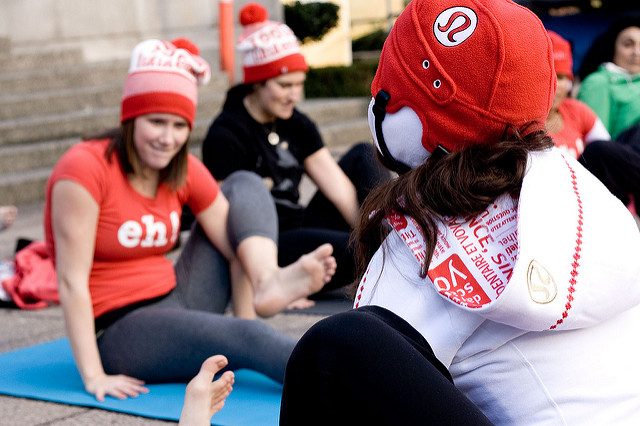Unlock the Magic in Your Story Now
Get the Free 20 questions to Ask Before Launching Your Idea workbook when you sign up for occasional updates.
Get the Free 20 questions to Ask Before Launching Your Idea workbook when you sign up for occasional updates.
Articles filed in: Storytelling
The Alternative To Winning The Awareness Game
filed in Marketing, Storytelling, Strategy
 The top 200 advertisers in the U.S. spent $137.9 Billion on ads in 2014. When you’ve got those resources it’s easy to play the awareness game.
The top 200 advertisers in the U.S. spent $137.9 Billion on ads in 2014. When you’ve got those resources it’s easy to play the awareness game.
What if newspaper presses came to a stop and banner ads were abolished on the grounds of inciting mindless consumption? Imagine a world where billboards were torn down to combat visual pollution and TV channels stopped interrupting programs with commercials.
What would our options to woo our customers be then?
There is more than one way to become both top of mind and close to heart. Patagonia employs 45 full time technicians to repair customer’s old and damaged clothing for free. Warby Parker offers a 5 day home try-on service. Tenzing Men’s Skincare sends free samples to prospective customers. Our local cafe invests in staff training to ensure that customers experience the best service in the world. Lululemon holds complimentary yoga classes and events. And these businesses link their sales to giving impacts with the help of B1G1.
What could you commit part of your advertising budget to in order to get closer to your customers?
Image by Shinsuke Ikegame.
Meaningful Work
filed in Storytelling, Strategy
 We’ve all witnessed a version of this in action. The speciality restaurant vowing to serve free range, grass fed and organic. The gift shop committed to selling local and artisanal. The designer who refuses to work with fast food companies. Uncompromising—until they think about scaling or they hit a bump in the road of their business.
We’ve all witnessed a version of this in action. The speciality restaurant vowing to serve free range, grass fed and organic. The gift shop committed to selling local and artisanal. The designer who refuses to work with fast food companies. Uncompromising—until they think about scaling or they hit a bump in the road of their business.
Staying committed to your intention, keeping the promises you made to the people you serve (and to yourself)—choosing to amplify your difference is at the heart of meaningful work.
What makes a compelling brand, an unforgettable book, or a piece of music that moves us is what the creator has chosen to leave out. The silence between two notes.
As the composer Gustavo Santaolalla said, “Not playing is sometimes more difficult.”
Knowing which notes to play is what makes all the difference.
Our job isn’t to play every possible note.
It’s to play one note every day that we’re proud to have played.
[And often to enable other people to do the same.]
Image by Timothy V.
The Power Of Customer Context
filed in Marketing, Storytelling, Strategy
 There’s a tiny hole-in-the-wall florist in the heart of the city, close to big office buildings and the cafes where people meet for breakfast and lunch. If it were an ordinary florist it would be the kind of place people would walk past on their way to somewhere else.
There’s a tiny hole-in-the-wall florist in the heart of the city, close to big office buildings and the cafes where people meet for breakfast and lunch. If it were an ordinary florist it would be the kind of place people would walk past on their way to somewhere else.
The neighbouring florist’s made-to-order, elaborate, cellophane-wrapped bouquets don’t cater to commuting office workers who live in small apartments on modest budgets. Meanwhile, the hole-in-the-wall sells out of simple, inexpensive, glass jars filled with wildflowers. The owner understands the power of the context in which the customer experiences his brand and how his product fits into her story.
There’s no need to second-guess the gesture of buying a little bunch that’s perfect for cheering up the corner of a desk on Monday morning (no vase or pre-ordering required), and no excuse not to celebrate the start of the weekend on the way to the tram on Friday night.
The more we put the customer at the centre of our marketing, the more we leave room for their story, the better our results will be. How are you doing that?
Image by mimmyg.
What Do You Want Your Audience To Remember?
filed in Storytelling, Strategy
 Many people who’ve read my latest book Meaningful: The story of ideas that fly say that the introduction impacted them the most. It would never have been written without a nudge from a trusted friend, who reminded me after he’d read the manuscript that some people might only read one page. We don’t always have the luxury of getting people to pay attention to everything we want them to remember. He told me to write the page people needed to read. This is what I wrote.
Many people who’ve read my latest book Meaningful: The story of ideas that fly say that the introduction impacted them the most. It would never have been written without a nudge from a trusted friend, who reminded me after he’d read the manuscript that some people might only read one page. We don’t always have the luxury of getting people to pay attention to everything we want them to remember. He told me to write the page people needed to read. This is what I wrote.
————
EVERY DAY COUNTS
Our deepest fear is that we will run out of places to hide—that one day there will be no boss who allows us to remain invisible and no political or economic circumstance that stops us from doing the most important work of our lives. We are the ultimate paradox. There are only two things we want—we want to hide and we want to be seen.
I know you’re scared that your idea might not work.
I know you worry about being wrong, far more than you celebrate the things you get right.
I know you waste time being anxious that you won’t measure up to someone else’s metric of success.
I know that some days you say one thing and do another.
Why else would the same New Year’s resolutions happen every new year?
I know you are afraid people will laugh at you.
I know that every day you walk a tightrope between getting over these fears and creating an impact.
I know you’re ‘this close’ to a breakthrough.
I wrestle with these fears, too. Every single day. On my best days, I put away my nervous laughter, the twenty emails I must answer and my to-do list, and I do the things I don’t have the courage to do on the days I want to hide. The things that matter—the kind of things I wish my brother had had a chance to do.
My brother never posted a photo on Facebook or created an iTunes playlist. He didn’t ever book a room on Airbnb or make a call from an iPhone. He never got to know what an app was and how magical the Internet would be. He will never walk across the Brooklyn Bridge or eat a moon pie in Gramercy Park. And he won’t be there to kiss his daughter when she turns eighteen in ten days’ time.
Johnny was the kid who wouldn’t come in from playing outside until the very last warning. He lit up any room just by walking into it. Like the Pied Piper, he had trails of friends who followed him and women who adored him (yes, he was impossibly good-looking, too). He was funny and magnetic and caring and genuine, and he died right on the cusp of a brand-new millennium, with a lot of dreams left inside him because he didn’t understand that there was no reason to wait for tomorrow to be better—that he didn’t need to hide. He was the most magnificent person who had everything he needed, and he didn’t know it.
Every day counts.
The two most important things we can do are to allow ourselves to be seen AND to really see others. The greatest gift you can give a person is to see who she is and to reflect that back to her. When we help people to be who they want to be, to take back some of the permission they deny themselves, we are doing our best, most meaningful work.
I see you.
————–
What’s the one thing your audience needs to hear? Go tell them.
Image by Salvaje.
How To Optimise For Customer Delight
filed in Marketing, Storytelling, Strategy
 “You’re here for the Valium?” blurted the dental receptionist as they arrived.
“You’re here for the Valium?” blurted the dental receptionist as they arrived.
The young man looked blankly at her and then at his mother. He was about to have three wisdom teeth removed under local anaesthetic. He had arrived early to be prepared for the procedure and dutifully took the 20mg of Valium given to calm him without understanding why. The dentist would be with them in an hour. Meanwhile, the receptionist continued through her checklist with the best of intentions, getting documentation signed and giving aftercare advice. The boy’s Dad pointed out three mistakes on the consent form before he signed it. All the while Sesame Street blared away on the television in the background of the otherwise empty waiting room.
Regardless of whether the procedure went well the level of empathy, attention to detail and care could have begun long before the patient sat in the dentist’s chair.
Every day we take our customers on a journey, along that journey there will be ‘moments of truth’—opportunities to either disappoint or delight. We often think of ‘moments of truth’ occurring in times of a customer service crisis and focus a lot of our energy on delighting in those moments, but ‘moments of truth’ happen routinely.
There are certain “givens” that customers expect, and they’re disappointed if they don’t happen. Then there are opportunities to create ‘magic’ which is where we often focus our customer service efforts. It’s natural to want to delight but we sometimes forget that focusing on the “givens” is as important as delivering the magic.
In our rush to delight the customer we can overlook the basics.
Paying attention to the ‘givens’ as much as the magic is how we delight. We must do both.
What are the “givens” in your customer’s journey and where is there an opportunity to create magic?
*Download and the Customer Delight PDF to make lists of opportunities you have to meet expectations and to create magic. Use this list to refine the customer experience and optimise for delight.
Image by Miss Messie.
How To Build Brand Equity
filed in Marketing, Storytelling, Strategy
 The toilet paper manufacturer has seemingly found a new way to increase customer engagement and build brand equity. Instead of just embossing patters on the paper, the company has decided to emboss its logo on every sheet. Imagine the meetings, time, energy and a myriad of other resources (including retooling of machines) that went into making and implementing this marketing decision. Now imagine the conversation that started the company on this journey to finding ways to create brand equity. Phrases like ‘captive audience’ (not so much), and ‘increased brand awareness’ were probably used, leading to many of the wrong questions being asked and answered.
The toilet paper manufacturer has seemingly found a new way to increase customer engagement and build brand equity. Instead of just embossing patters on the paper, the company has decided to emboss its logo on every sheet. Imagine the meetings, time, energy and a myriad of other resources (including retooling of machines) that went into making and implementing this marketing decision. Now imagine the conversation that started the company on this journey to finding ways to create brand equity. Phrases like ‘captive audience’ (not so much), and ‘increased brand awareness’ were probably used, leading to many of the wrong questions being asked and answered.
Brand equity is not created by sticking a logo where a customer has no choice but to see it. Brand equity evolves when the brand is so meaningful to the customer that it becomes part of her story. It doesn’t happen when she sees the logo, but when she wants to be seen with it. Big difference.
The reason the backpacker at the airport covers every part of her 15 inch Macbook apart from the Apple logo with a heavy duty protective case, is because she wants people to know that she is part of the Apple tribe. Her Macbook is as much a part of her identity as the battered, bright yellow, sticker-covered violin case she rests her foot on while she surfs the Internet in the departure lounge.
We don’t commandeer brand equity with adverts or increased exposure. We earn it when we change how the customer feels about herself in the presence of our brand. And yes, it’s even possible to do that with a toilet paper brand, just not in the way we might have done fifty years ago.
Image by Shandi-lee Cox..
Good Marketing
filed in Marketing, Storytelling
 As she’s scanning organic bananas or buckwheat kernels at the checkout the assistant at local health food store strikes up a conversation. She’s curious to know if the bananas are just for making smoothies and what the customer uses the buckwheat for. These seemingly insignificant interactions are hardly worth remembering and yet over time they spark ideas for new menu items to be introduced at the in-store cafe and give rise to opportunities to better serve her community of customers.
As she’s scanning organic bananas or buckwheat kernels at the checkout the assistant at local health food store strikes up a conversation. She’s curious to know if the bananas are just for making smoothies and what the customer uses the buckwheat for. These seemingly insignificant interactions are hardly worth remembering and yet over time they spark ideas for new menu items to be introduced at the in-store cafe and give rise to opportunities to better serve her community of customers.
Good marketing starts with the customer’s needs and wants, not with the company’s emergency.
A great marketing strategy is geared towards creating lasting connections instead of simply being focused on reaching short term targets.
The gifted marketer doesn’t simply try to sell what’s in stock today. She strives to understand what her customer will want tomorrow and then creates the culture and momentum to deliver that.
If your success and profits are by-product of satisfied customers, it stands to reason that your priority is to matter, not simply to make and sell.
Image by G. Morel.
The Customer Referral Source Changes The Story
filed in Marketing, Storytelling, Strategy
 Not all prospective customer enquiries are created equal.
Not all prospective customer enquiries are created equal.
An enquiry via website contact form, made as a result of a Google search is very different from a direct referral from a friend. It’s also worth remembering that the customer’s story at the time she seeks you out changes the sales conversation.
How and when a potential customer finds you has a bearing on the story she is ready to hear and the value you can create for her in the moment. It’s just as important to focus on her circumstances and worldview and to allocate resources to that as it is to hone the brand story you want to tell.
Image by Kejing GU.
 How is it that we can go into the same cafe two days running, order the same drink, pay the same price and yet leave feeling entirely different about the experience depending on the interaction we have with the person who is serving?
How is it that we can go into the same cafe two days running, order the same drink, pay the same price and yet leave feeling entirely different about the experience depending on the interaction we have with the person who is serving? Grace is 32 years old, she has worked hard to establish herself on the career ladder and bought her first home. Grace and her partner Mike are trying for a baby. As marketers with a brand story to tell we’re in a hurry to gather as much data as we can about Grace. We want to know her postcode, where she shops and what she chooses. We want to know how much she earns and how many people live in her household. Of course, there are companies, algorithms and applications that can filter this data for us.
Grace is 32 years old, she has worked hard to establish herself on the career ladder and bought her first home. Grace and her partner Mike are trying for a baby. As marketers with a brand story to tell we’re in a hurry to gather as much data as we can about Grace. We want to know her postcode, where she shops and what she chooses. We want to know how much she earns and how many people live in her household. Of course, there are companies, algorithms and applications that can filter this data for us.